Burt A. The Evolution of the British Empire and Commonwealth From the American Revolution
Подождите немного. Документ загружается.

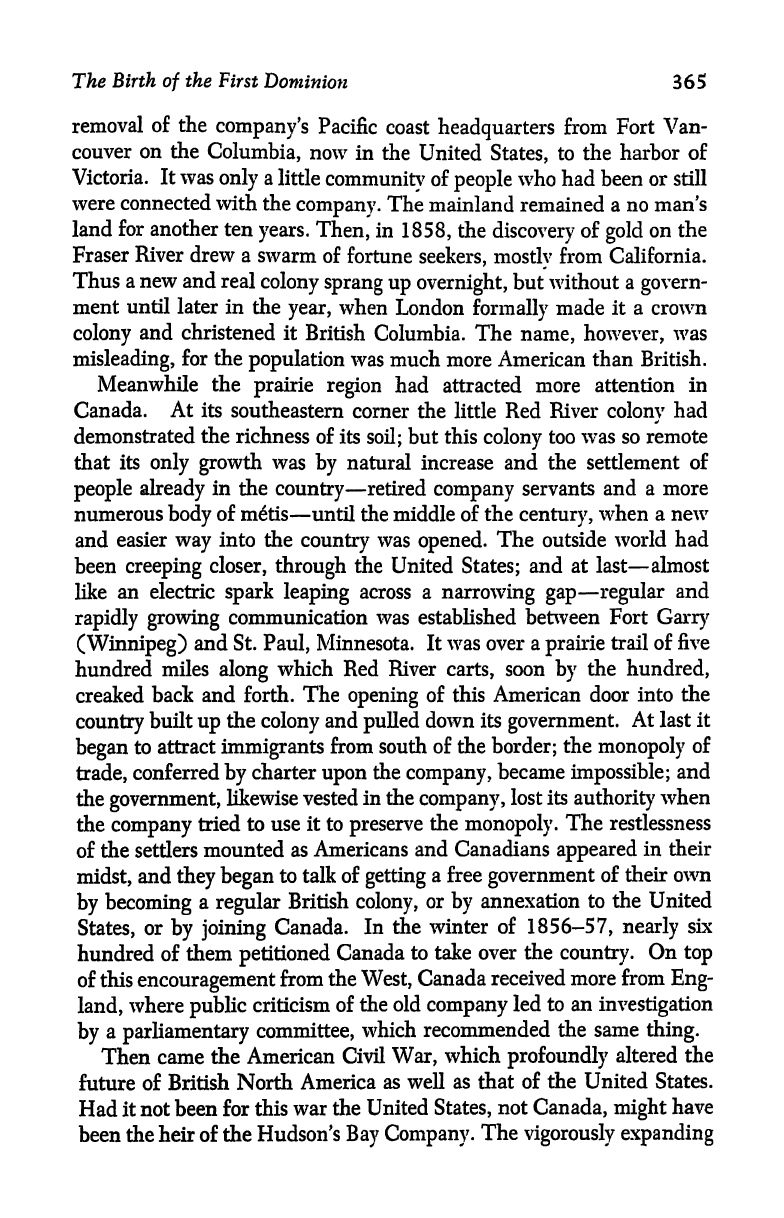
The
Birth
of
the First
Dominion
365
removal
of the
company's
Pacific
coast
headquarters
from
Fort
Van-
couver
on the
Columbia,
now
in
the
United
States,
to
the harbor
of
Victoria.
It was
only
a
little
community
of
people
who
had been
or
still
were connected
with the
company.
The
mainland
remained a no
man's
land
for
another
ten
years.
Then,
in
1858,
the
discovery
of
gold
on
the
Eraser
River
drew
a
swarm
of
fortune
seekers,
mostly
from California.
Thus
a new
and
real
colony
sprang
up
overnight,
but
without
a
govern-
ment
until later
in
the
year,
when
London
formally
made
it
a
crown
colony
and
christened it
British
Columbia. The
name, however,
was
misleading,
for the
population
was
much
more American
than British.
Meanwhile the
prairie
region
had attracted more
attention
in
Canada.
At
its
southeastern
corner the little Red
River
colony
had
demonstrated
the
richness of
its
soil;
but
this
colony
too
was
so
remote
that
its
only
growth
was
by
natural
increase and the settlement
of
people
already
in
the
country
retired
company
servants
and a more
numerous
body
of metis
until the middle of
the
century,
when
a new
and
easier
way
into the
country
was
opened.
The
outside
world
had
been
creeping
closer,
through
the
United
States;
and at last
almost
like
an
electric
spark
leaping
across
a
narrowing gap regular
and
rapidly growing
communication was established
between Fort
Garry
(Winnipeg)
and
St.
Paul,
Minnesota. It
was
over
a
prairie
trail of
five
hundred
miles
along
which Red River
carts,
soon
by
the
hundred,
creaked
back
and forth. The
opening
of this
American door
into
the
country
built
up
the
colony
and
pulled
down its
government.
At
last
it
began
to
attract
immigrants
from south of the
border;
the
monopoly
of
trade,
conferred
by
charter
upon
the
company,
became
impossible;
and
the
government,
likewise
vested
in the
company,
lost
its
authority
when
the
company
tried to
use it to
preserve
the
monopoly.
The restlessness
of
the settlers
mounted
as
Americans
and Canadians
appeared
in
their
midst,
and
they began
to talk of
getting
a free
government
of
their own
by
becoming
a
regular
British
colony,
or
by
annexation to
the United
States,
or
by joining
Canada.
In
the winter
of
1856-57,
nearly
six
hundred
of
them
petitioned
Canada
to
take over the
country.
On
top
of
this
encouragement
from
the
West,
Canada
received
more
from
Eng-
land,
where
public
criticism
of
the
old
company
led
to an
investigation
by
a
parliamentary
committee,
which recommended
the same
thing.
Then
came
the
American
Civil
War,
which
profoundly
altered
the
future of
British
North
America
as well
as
that
of
the
United States.
Had
it
not been
for this
war
the United
States,
not
Canada,
might
have
been the
heir of
the
Hudson's
Bay
Company.
The
vigorously expanding
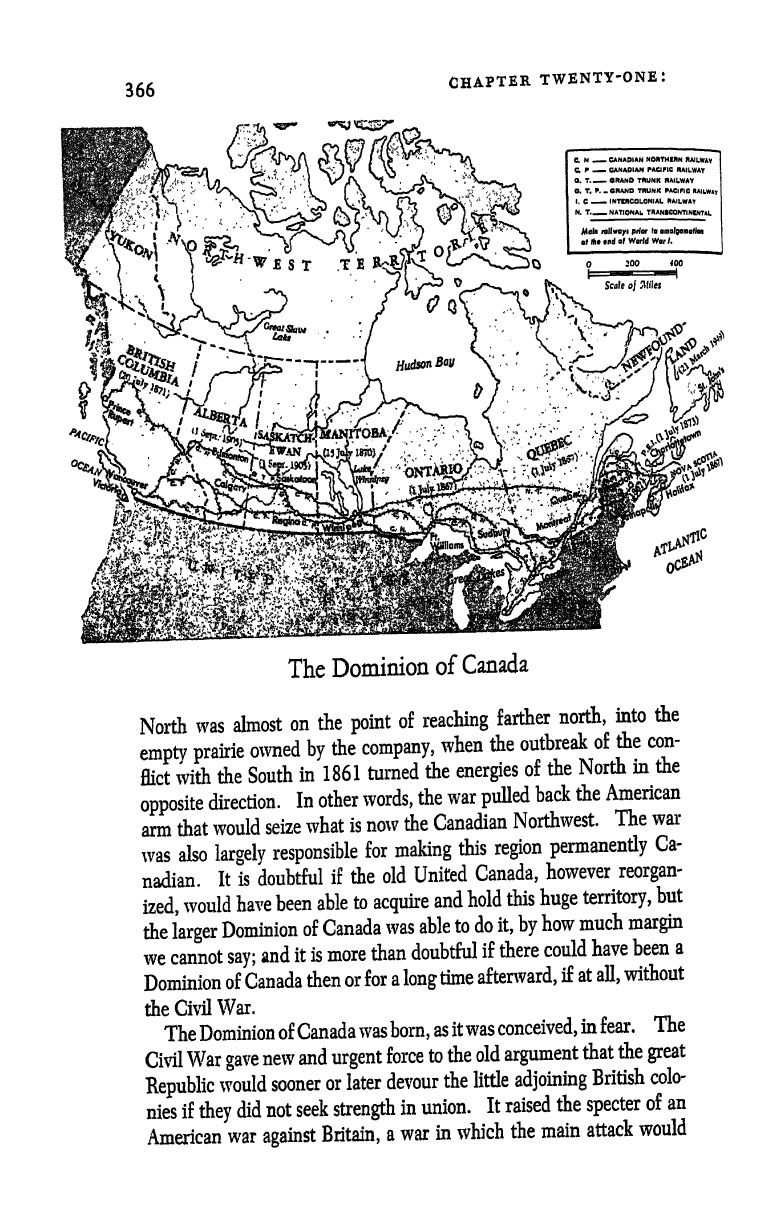
366
CHAPTER
TWENTY-ONE:
C.
N CANADIAN
NORTHERN
RAILWAY
C,
P
CANADIAN
PACIFIC
RAILWAY
O.
T.
GRAND
TRUNK
RAILWAY
0.
T.
P. _
GRAND
TRUNK
PACIFIC
RAILWAY
1. C
INTERCOLONIAL RAILWAY
N.
T.__
NATIONAL
TRANSCONTINENTAL
The
Dominion
of
Canada
North
was
almost
on
the
point
of
reaching
farther north,
into
the
empty
prairie
owned
by
the
company,
when
the
outbreak
of
die con-
flict
with
the
South
in
1861
turned
the
energies
of
the
North
in
the
opposite
direction.
In other
words,
the
war
pulled
back
the
American
arm
that
would
seize
what
is
now
the
Canadian
Northwest.
The
war
was
also
largely
responsible
for
making
this
region
permanently
Ca-
nadian.
It
is doubtful
if
the
old
United Canada,
however
reorgan-
ized,
would
have
been
able
to
acquire
and
hold
this
huge
territory,
but
the
larger
Dominion
of
Canada
was
able
to
do
it,
by
how
much
margin
we
cannot
say;
and
it is
more
than
doubtful
if
there
could
have
been
a
Dominion
of Canada
then
or
for
a
long
time
af
terward,
if
at
all,
without
the
Civil
War.
The
Dominion
of Canada
was
born,
as it
was
conceived,
in
fear.
The
Civil
War
gave
new
and
urgent
force
to the
old
argument
that
the
great
Republic
would
sooner
or
later
devour
the
little
adjoining
British
colo-
nies
if
they
did
not
seek
strength
in
union.
It raised
the
specter
of
an
American
war
against
Britain,
a
war
in
which
the
main
attack
would
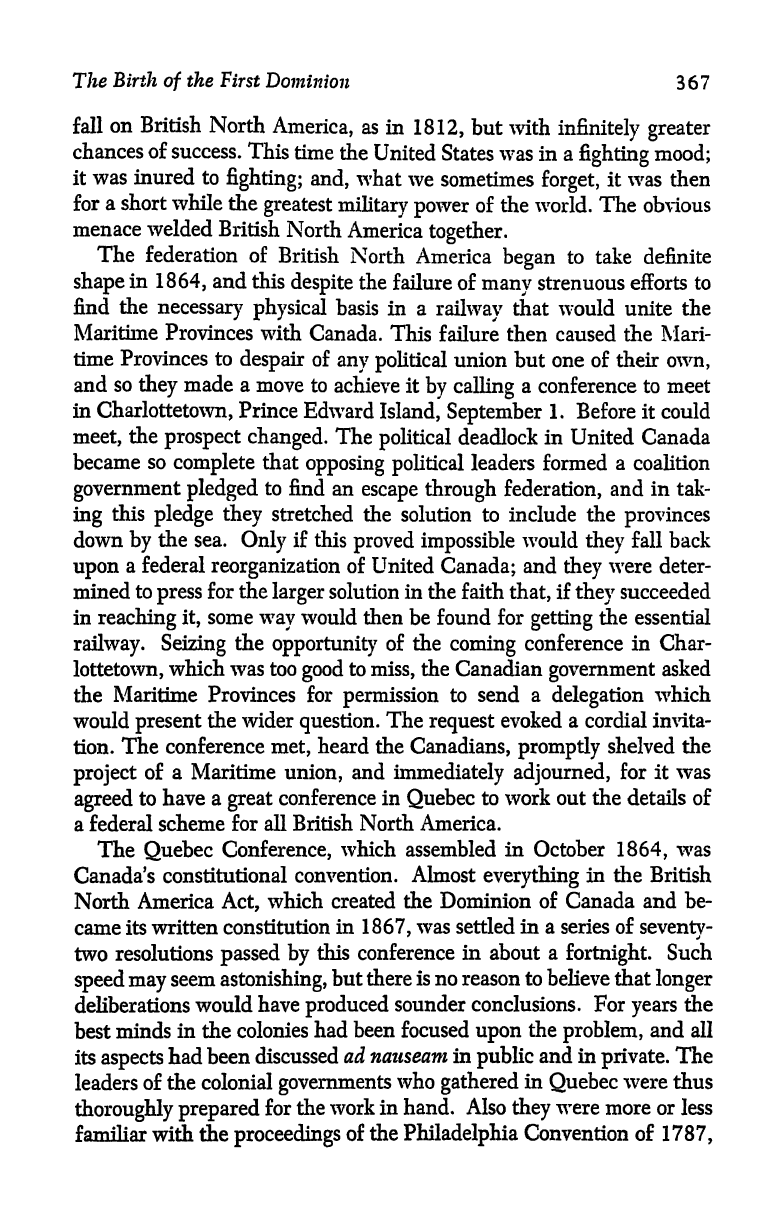
The
Birth
of
the
First
Dominion
367
fall
on
British
North
America,
as
in
1812,
but with
infinitely
greater
chances
of success.
This
time
the
United
States
was in a
fighting
mood;
it
was
inured to
fighting;
and,
what
we
sometimes
forget,
it was then
for
a short while
the
greatest
military
power
of the
world.
The obvious
menace
welded
British
North
America
together.
The
federation
of
British
North
America
began
to take definite
shape
in
1864,
and this
despite
the
failure
of
many
strenuous
efforts
to
find
the
necessary
physical
basis in a
railway
that
would unite
the
Maritime
Provinces
with
Canada.
This failure then caused the
Mari-
time Provinces
to
despair
of
any political
union
but
one of
their
own,
and
so
they
made
a
move
to
achieve
it
by
calling
a conference to meet
in
Charlottetown,
Prince
Edward
Island,
September
1. Before
it
could
meet,
the
prospect
changed.
The
political
deadlock
in United Canada
became
so
complete
that
opposing
political
leaders formed
a
coalition
government
pledged
to
find an
escape
through
federation,
and
in tak-
ing
this
pledge
they
stretched
the solution
to include
the
provinces
down
by
the
sea.
Only
if this
proved impossible
would
they
fall back
upon
a
federal
reorganization
of
United
Canada;
and
they
were
deter-
mined
to
press
for the
larger
solution
in the
faith
that,
if
they
succeeded
in
reaching
it,
some
way
would
then
be
found for
getting
tiie
essential
railway.
Seizing
the
opportunity
of
the
coming
conference
in Char-
lottetown,
which
was
too
good
to
miss,
the
Canadian
government
asked
the Maritime
Provinces for
permission
to
send
a
delegation
which
would
present
the wider
question.
The
request
evoked
a
cordial
imita-
tion.
The conference
met,
heard the
Canadians,
promptly
shelved the
project
of
a Maritime
union,
and
immediately adjourned,
for
it
was
agreed
to
have
a
great
conference
in
Quebec
to work out the
details
of
a federal scheme
for all British North America.
The
Quebec
Conference,
which assembled
in
October
1864,
was
Canada's
constitutional
convention.
Almost
everything
in
the British
North
America
Act,
which created
the
Dominion
of
Canada
and be-
came
its
written
constitution
in
1867,
was
settled
in a
series of
seventy-
two
resolutions
passed
by
this
conference
in
about
a
fortnight.
Such
speed
may
seem
astonishing,
but there
is
no reason to believe
that
longer
deliberations
would
have
produced
sounder
conclusions.
For
years
the
best
minds
in
the colonies
had
been
focused
upon
the
problem,
and all
its
aspects
had
been
discussed
ad nauseam in
public
and in
private.
The
leaders
of the colonial
governments
who
gathered
in
Quebec
were
thus
thoroughly
prepared
for
the
work in hand.
Also
they
were
more or
less
familiar
with the
proceedings
of
the
Philadelphia
Convention of
1787,
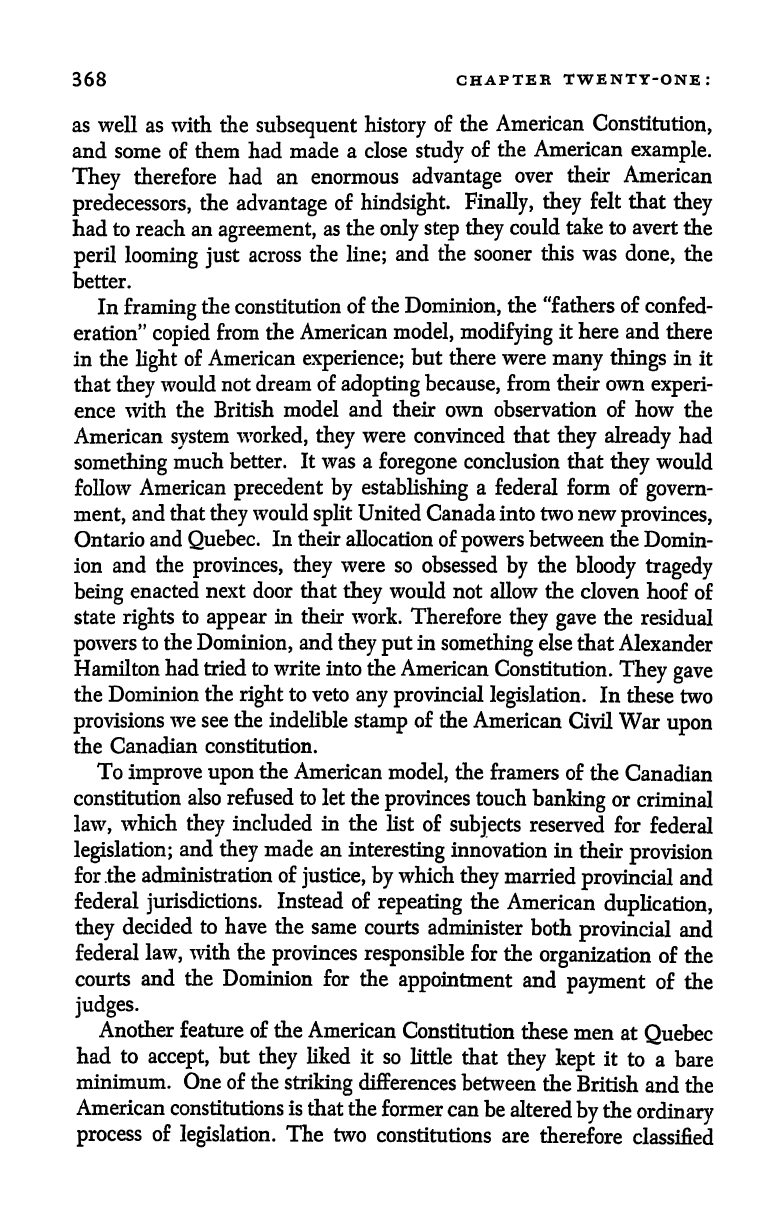
368
CHAPTER
TWENTY-ONE:
as
well as with the
subsequent
history
of
the
American
Constitution,
and
some
of
them
had
made a
close
study
of
the
American
example.
They
therefore had
an
enormous
advantage
over their
American
predecessors,
the
advantage
of
hindsight.
Finally, they
felt
that
they
had
to
reach an
agreement,
as
the
only
step
they
could take to avert
the
peril
looming
just
across
the
line;
and
the sooner
this was
done,
the
better.
In
framing
the constitution
of
the
Dominion,
the "fathers of
confed-
eration"
copied
from the
American
model,
modifying
it here
and
there
in
the
light
of
American
experience;
but there were
many
things
in
it
that
they
would
not
dream
of
adopting
because,
from
their
own
experi-
ence
with
the British
model and their
own observation of how
the
American
system
worked,
they
were
convinced
that
they
already
had
something
much
better.
It
was
a
foregone
conclusion
that
they
would
follow
American
precedent by
establishing
a
federal form of
govern-
ment,
and
that
they
would
split
United
Canada into two new
provinces,
Ontario
and
Quebec.
In their
allocation
of
powers
between
the
Domin-
ion
and
the
provinces, they
were
so
obsessed
by
the
bloody
tragedy
being
enacted
next door that
they
would not allow the
cloven
hoof
of
state
rights
to
appear
in their
work.
Therefore
they
gave
the
residual
powers
to the
Dominion,
and
they put
in
something
else
that
Alexander
Hamilton had
tried
to
write
into
the
American
Constitution.
They
gave
the
Dominion
the
right
to veto
any provincial
legislation.
In
these
two
provisions
we see the
indelible
stamp
of
the
American
Civil War
upon
the Canadian
constitution.
To
improve upon
the
American
model,
the
framers
of
the
Canadian
constitution
also
refused to
let
the
provinces
touch
banking
or
criminal
law,
which
they
included
in
the
list
of
subjects
reserved
for
federal
legislation;
and
they
made an
interesting
innovation
in
their
provision
for .the
administration of
justice,
by
which
they
married
provincial
and
federal
jurisdictions.
Instead
of
repeating
the
American
duplication,
they
decided
to have
the same
courts
administer
both
provincial
and
federal
law,
with
the
provinces
responsible
for
the
organization
of
the
courts
and the
Dominion
for
the
appointment
and
payment
of the
judges.
Another feature
of the
American
Constitution
these
men
at
Quebec
had to
accept,
but
they
liked it
so
little
that
they
kept
it
to a
bare
minimum.
One
of the
striking
differences
between
the
British
and the
American
constitutions
is
that the
former
can
be
altered
by
the
ordinary
process
of
legislation.
The
two
constitutions are
therefore
classified
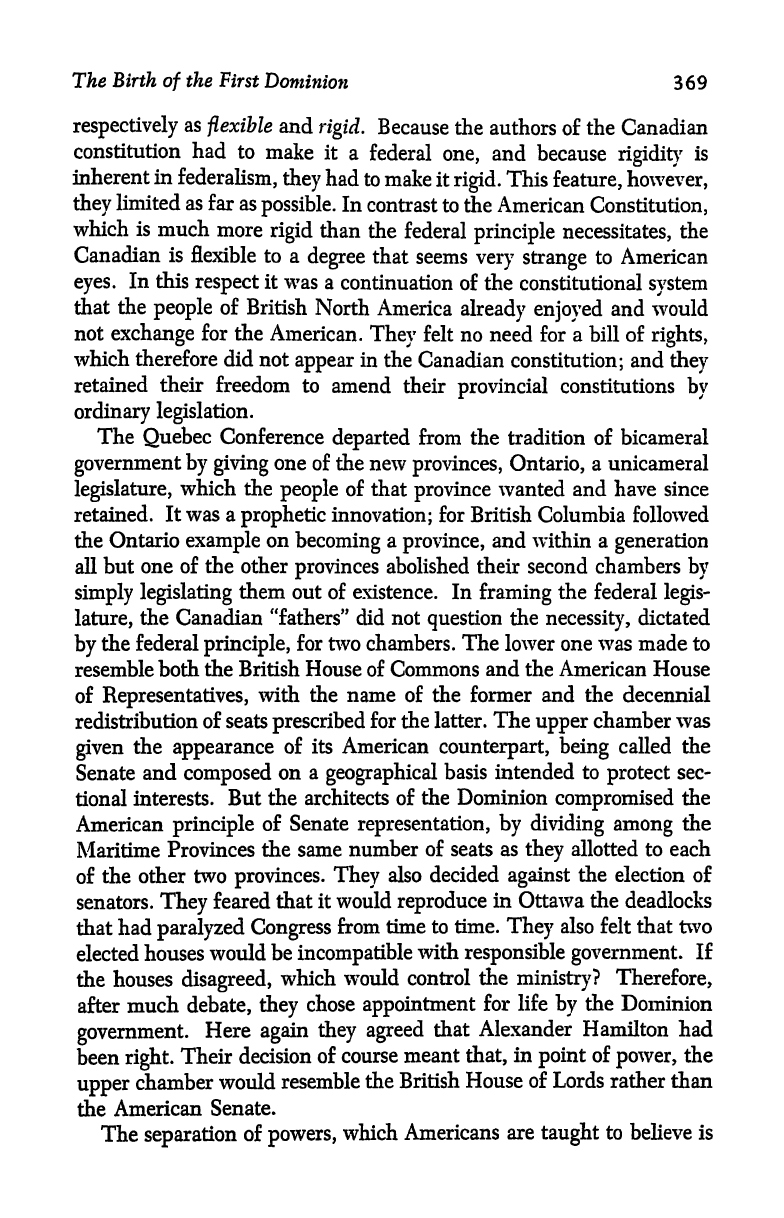
The
Birth
of
the
First
Dominion
369
respectively
as
flexible
and
rigid.
Because the
authors
of
the
Canadian
constitution
had
to
make it
a
federal
one,
and because
rigidity
is
inherent
in
federalism,
they
had
to make
it
rigid.
This
feature,
however,
they
limited as
far
as
possible.
In
contrast
to the
American
Constitution,
which
is
much
more
rigid
than
the
federal
principle
necessitates,
the
Canadian
is
flexible to
a
degree
that seems
very
strange
to
American
eyes.
In this
respect
it
was
a
continuation
of the constitutional
system
that
the
people
of
British
North
America
already
enjoyed
and
would
not
exchange
for the
American.
They
felt
no need for
a
bill of
rights,
which therefore did
not
appear
in the
Canadian
constitution;
and
they
retained
their
freedom
to
amend their
provincial
constitutions
by
ordinary
legislation.
The
Quebec
Conference
departed
from the tradition of bicameral
government
by
giving
one
of
the
new
provinces,
Ontario,
a unicameral
legislature,
which the
people
of
that
province
wanted
and have since
retained.
It
was
a
prophetic
innovation;
for British
Columbia
followed
the
Ontario
example
on
becoming
a
province,
and
within a
generation
all
but
one of the other
provinces
abolished their
second
chambers
by
simply
legislating
them out of existence. In
framing
the
federal
legis-
lature,
the
Canadian "fathers"
did
not
question
the
necessity,
dictated
by
the
federal
principle,
for
two chambers.
The
lower
one was
made
to
resemble
both
the British House
of
Commons
and the American House
of
Representatives,
with the
name
of the former and
the
decennial
redistribution
of seats
prescribed
for
the
latter.
The
upper
chamber
was
given
the
appearance
of its
American
counterpart,
being
called the
Senate
and
composed
on
a
geographical
basis intended
to
protect
sec-
tional
interests.
But the architects
of
the
Dominion
compromised
the
American
principle
of
Senate
representation,
by dividing
among
the
Maritime
Provinces
the
same
number
of seats
as
they
allotted to each
of
the
other
two
provinces.
They
also
decided
against
the
election of
senators.
They
feared
that it
would
reproduce
in
Ottawa the
deadlocks
that
had
paralyzed
Congress
from time to
time.
They
also
felt
that
two
elected
houses
would be
incompatible
with
responsible
government.
If
the houses
disagreed,
which would
control
the
ministry?
Therefore,
after
much
debate,
they
chose
appointment
for life
by
the
Dominion
government.
Here
again
they
agreed
that
Alexander Hamilton had
been
right.
Their
decision
of
course
meant
that,
in
point
of
power,
the
upper
chamber
would
resemble
the British House
of Lords rather
than
the
American
Senate.
The
separation
of
powers,
which
Americans
are
taught
to
believe is
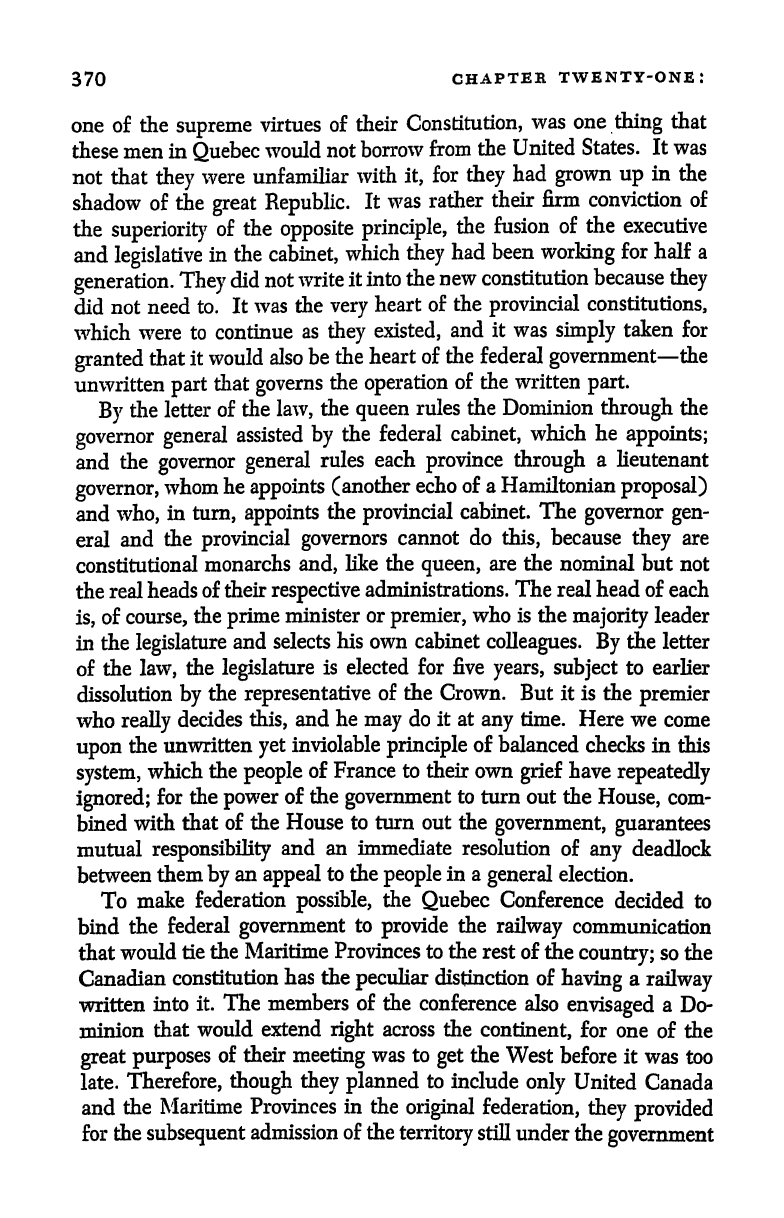
370
CHAPTER
TWENTY-ONE:
one
of
the
supreme
virtues
of
their
Constitution,
was
one
thing
that
these men
in
Quebec
would
not
borrow
from
the
United
States.
It
was
not that
they
were
unfamiliar
with
it,
for
they
had
grown
up
in
the
shadow of
the
great
Republic.
It
was
rather
their
firm
conviction
of
the
superiority
of
the
opposite
principle,
the
fusion of
the
executive
and
legislative
in
the
cabinet,
which
they
had
been
working
for half a
generation.
They
did
not
write
it
into the
new constitution
because
they
did
not
need
to.
It
was the
very
heart of
the
provincial
constitutions,
which
were
to
continue
as
they
existed,
and it
was
simply
taken for
granted
that
it
would
also
be
the heart
of
the federal
government
the
unwritten
part
that
governs
the
operation
of the
written
part.
By
the
letter
of
the
law,
the
queen
rules the Dominion
through
the
governor
general
assisted
by
the
federal
cabinet,
which
he
appoints;
and
the
governor
general
rules
each
province
through
a
lieutenant
governor,
whom
he
appoints
(another
echo
of a Hamiltonian
proposal)
and
who,
in
turn,
appoints
the
provincial
cabinet.
The
governor
gen-
eral
and
the
provincial
governors
cannot do
this,
because
they
are
constitutional
monarchs
and,
like the
queen,
are
the nominal but
not
the
real
heads
of
their
respective
administrations. The real
head
of each
is,
of
course,
the
prime
minister
or
premier,
who
is the
majority
leader
in
the
legislature
and selects
his own
cabinet
colleagues.
By
the letter
of
the
law,
the
legislature
is
elected for five
years, subject
to earlier
dissolution
by
the
representative
of the Crown. But
it is the
premier
who
really
decides
this,
and
he
may
do
it at
any
time.
Here we
come
upon
the
unwritten
yet
inviolable
principle
of
balanced
checks in
this
system,
which
the
people
of France
to
their
own
grief
have
repeatedly
ignored;
for
the
power
of
the
government
to turn out
the
House,
com-
bined
with
that
of the
House to turn out the
government,
guarantees
mutual
responsibility
and an
immediate
resolution
of
any
deadlock
between
them
by
an
appeal
to
the
people
in
a
general
election.
To
make
federation
possible,
the
Quebec
Conference
decided
to
bind
the
federal
government
to
provide
the
railway
communication
that
would
tie
the
Maritime Provinces to the
rest
of
the
country;
so
the
Canadian
constitution
has the
peculiar
distinction
of
having
a
railway
written
into
it.
The
members of the
conference
also
envisaged
a
Do-
minion
that
would
extend
right
across
the
continent,
for one
of
the
great
purposes
of
their
meeting
was to
get
the
West
before it
was
too
late.
Therefore,
though
they planned
to
include
only
United Canada
and
the
Maritime Provinces
in
the
original
federation,
they
provided
for
the
subsequent
admission of
the
territory
still
under
the
government
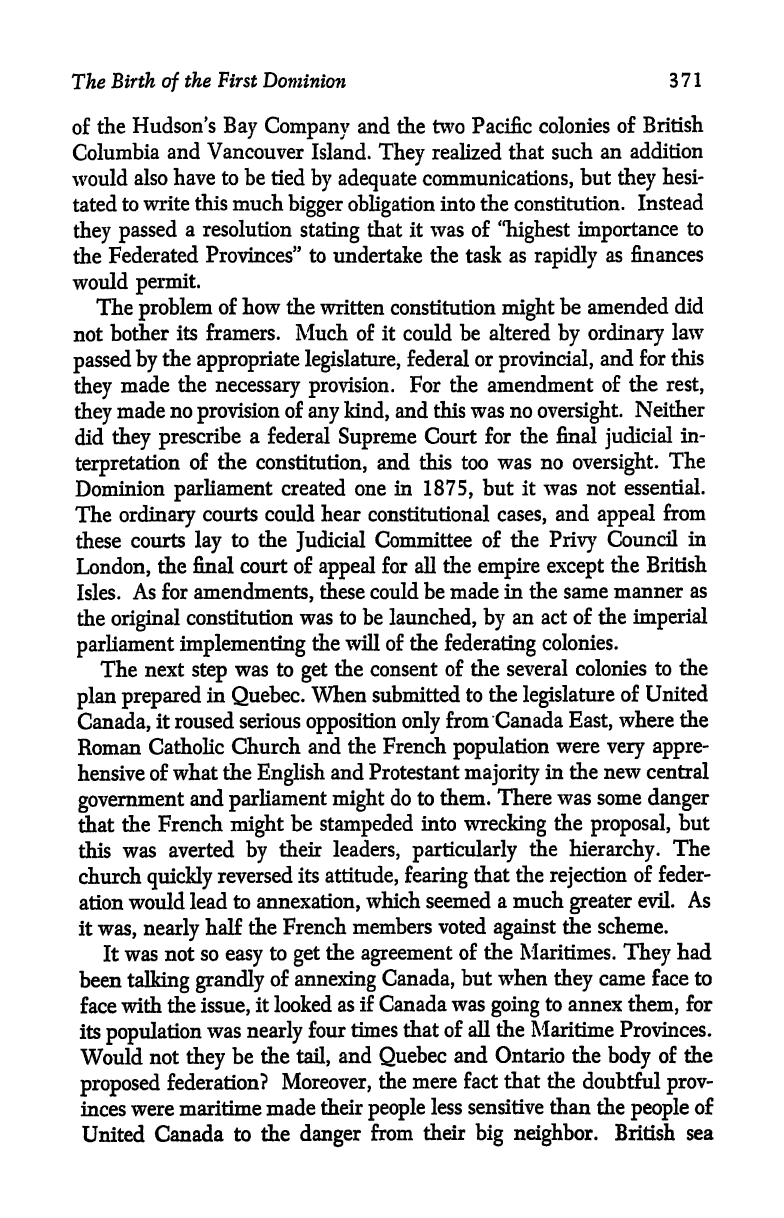
The
Birth
of
the First
Dominion
3
7 1
of
the
Hudson's
Bay
Company
and
the two Pacific
colonies
of
British
Columbia
and Vancouver
Island.
They
realized that such
an
addition
would
also have to be
tied
by
adequate
communications,
but
they
hesi-
tated
to
write
this
much
bigger
obligation
into the constitution.
Instead
they
passed
a
resolution
stating
that it was of
"highest
importance
to
the
Federated
Provinces" to
undertake
the
task
as
rapidly
as finances
would
permit.
The
problem
of how the
written constitution
might
be amended
did
not
bother
its framers. Much
of it could be
altered
by
ordinary
law
passed
by
the
appropriate
legislature,
federal
or
provincial,
and for
this
they
made
the
necessary provision.
For
the
amendment
of the
rest,
they
made
no
provision
of
any
kind,
and
this was no
oversight.
Neither
did
they
prescribe
a
federal
Supreme
Court
for
the final
judicial
in-
terpretation
of the
constitution,
and
this
too
was
no
oversight.
The
Dominion
parliament
created one in
1875,
but
it was not
essential.
The
ordinary
courts
could
hear
constitutional
cases,
and
appeal
from
these
courts
lay
to
the
Judicial
Committee of
the
Privy
Council
in
London,
the
final
court
of
appeal
for
all the
empire
except
the British
Isles.
As for
amendments,
these
could
be made in
the
same
manner
as
the
original
constitution
was
to
be
launched,
by
an act of the
imperial
parliament
implementing
the
will of
the
federating
colonies.
The
next
step
was
to
get
the consent
of the several
colonies
to
the
plan
prepared
in
Quebec.
When
submitted
to
the
legislature
of United
Canada,
it
roused
serious
opposition
only
from Canada
East,
where
the
Roman
Catholic
Church and
the
French
population
were
very appre-
hensive
of
what
the
English
and Protestant
majority
in the
new
central
government
and
parliament might
do to
them.
There was some
danger
that
the French
might
be
stampeded
into
wrecking
the
proposal,
but
this
was
averted
by
their
leaders,
particularly
the
hierarchy.
The
church
quickly
reversed
its
attitude,
fearing
that the
rejection
of feder-
ation
would
lead
to
annexation,
which seemed
a
much
greater
evil.
As
it
was,
nearly
half
the
French
members voted
against
the
scheme.
It
was not so
easy
to
get
the
agreement
of
the Maritimes.
They
had
been
talking grandly
of
annexing
Canada,
but when
they
came face
to
face
with the
issue,
it looked
as
if
Canada
was
going
to annex
them,
for
its
population
was
nearly
four
times that of
all
the Maritime Provinces.
Would
not
they
be
the
tail,
and
Quebec
and Ontario the
body
of
the
proposed
federation?
Moreover,
the
mere fact
that
the
doubtful
prov-
inces
were
maritime
made
their
people
less
sensitive than
the
people
o
United
Canada
to
the
danger
from
their
big neighbor.
British
sea
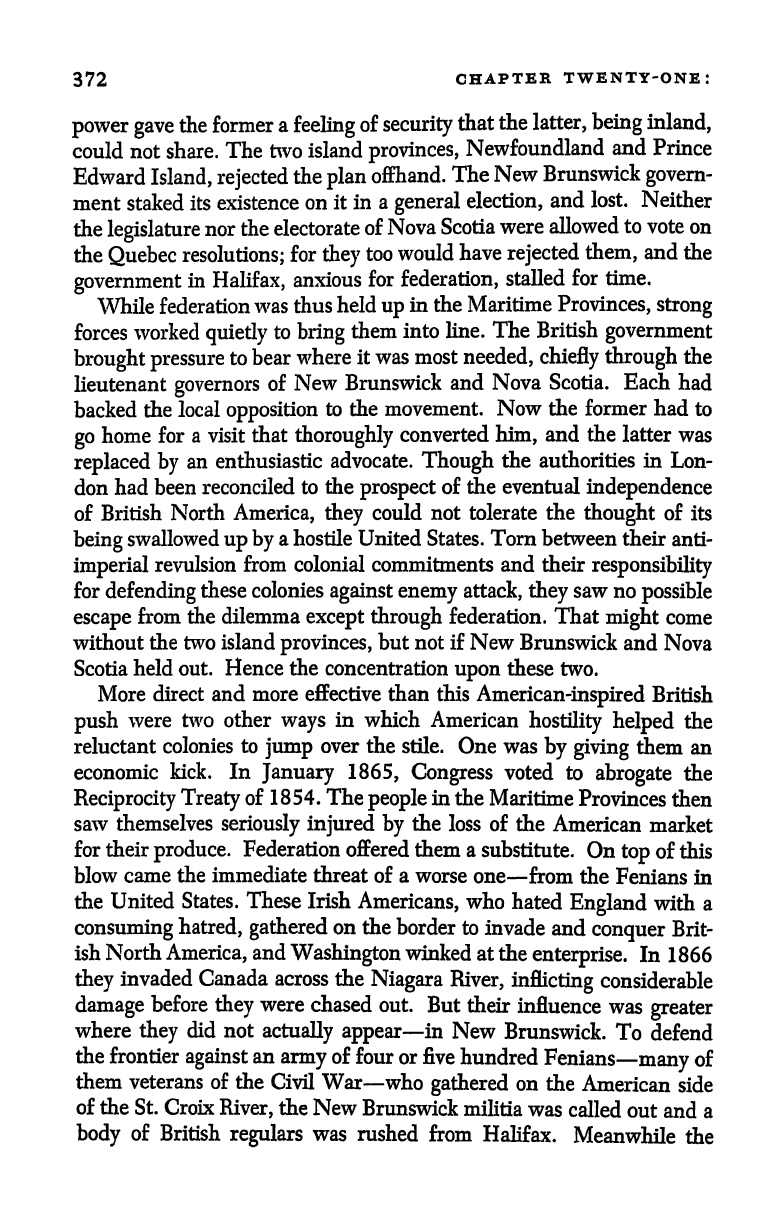
372
CHAPTER
TWENTY-ONE:
power
gave
the former
a
feeling
of
security
that
the
latter,
being
inland,
could not share.
The two
island
provinces,
Newfoundland
and
Prince
Edward
Island,
rejected
the
plan
offhand.
The
New
Brunswick
govern-
ment
staked
its
existence
on
it
in
a
general
election,
and
lost.
Neither
the
legislature
nor
the electorate
of
Nova
Scotia
were
allowed
to
vote
on
the
Quebec
resolutions;
for
they
too
would
have
rejected
them,
and
the
government
in
Halifax,
anxious
for
federation,
stalled
for
time.
While
federation
was thus
held
up
in the Maritime
Provinces,
strong
forces
worked
quietly
to
bring
them
into line.
The British
government
brought
pressure
to bear
where
it
was most
needed,
chiefly
through
the
lieutenant
governors
of
New
Brunswick
and Nova
Scotia.
Each
had
backed
the
local
opposition
to the
movement.
Now
the
former
had
to
go
home
for
a
visit
that
thoroughly
converted
him,
and
the
latter
was
replaced
by
an
enthusiastic
advocate.
Though
the authorities in
Lon-
don
had been
reconciled
to the
prospect
of the eventual
independence
of
British
North
America,
they
could
not tolerate the
thought
of
its
being
swallowed
up by
a
hostile United States.
Torn between their
anti-
imperial
revulsion
from
colonial commitments and their
responsibility
for
defending
these colonies
against
enemy
attack,
they
saw
no
possible
escape
from
the dilemma
except through
federation.
That
might
come
without
the two island
provinces,
but not
if
New
Brunswick
and
Nova
Scotia
held out.
Hence the concentration
upon
these two.
More
direct
and more effective than
this
American-inspired
British
push
were
two
other
ways
in which
American
hostility
helped
the
reluctant
colonies
to
jump
over
the
stile.
One
was
by
giving
diem an
economic
kick.
In
January
1865,
Congress
voted to
abrogate
the
Reciprocity Treaty
of
1854.
The
people
in the
Maritime
Provinces then
saw
themselves
seriously injured
by
the
loss of the
American
market
for
their
produce.
Federation
offered them
a
substitute.
On
top
of this
blow
came
the immediate threat
of
a
worse
one
from
the
Fenians in
the
United
States. These Irish
Americans,
who
hated
England
with a
consuming
hatred,
gathered
on the
border to
invade
and
conquer
Brit-
ish
North
America,
and
Washington
winked at
the
enterprise.
In
1866
they
invaded Canada across
the
Niagara
River,
inflicting
considerable
damage
before
they
were
chased out.
But
their
influence
was
greater
where
they
did not
actually appear
in
New
Brunswick.
To
defend
the
frontier
against
an
army
of
four
or five
hundred
Fenians
many
of
them
veterans of
the
Civil War
who
gathered
on
the
American
side
of the
St. Croix
River,
the New
Brunswick
militia
was
called
out
and a
body
of
British
regulars
was
rushed from
Halifax.
Meanwhile
the
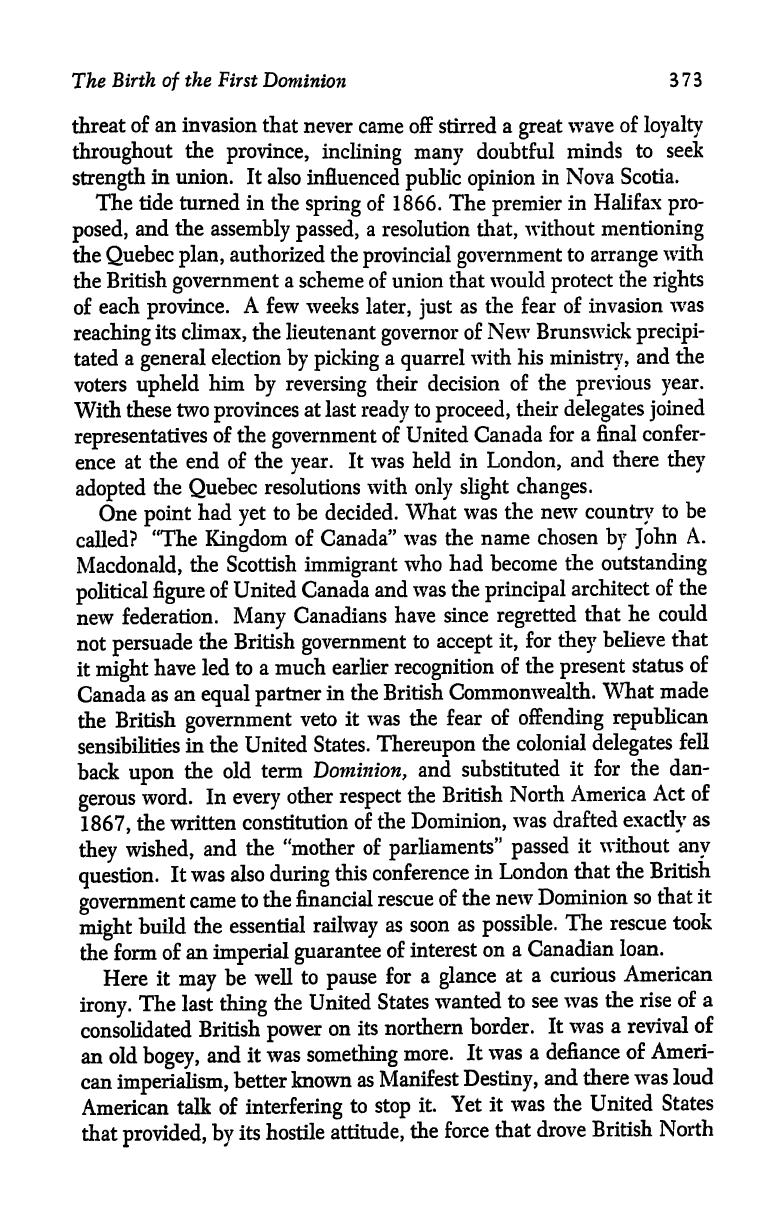
The
Birth
of
the First
Dominion
373
threat
of
an
invasion
that
never
came off stirred
a
great
wave
of
loyalty
throughout
the
province,
inclining many
doubtful
minds
to
seek
strength
in union. It
also
influenced
public
opinion
in Nova
Scotia.
The
tide
turned
in
the
spring
of 1866.
The
premier
in Halifax
pro-
posed,
and
the
assembly passed,
a
resolution
that,
without
mentioning
the
Quebec
plan,
authorized
the
provincial government
to
arrange
with
the
British
government
a
scheme
of union
that
would
protect
the
rights
of
each
province.
A
few
weeks
later,
just
as
the
fear
of
invasion
was
reaching
its
climax,
the lieutenant
governor
of
New Brunswick
precipi-
tated
a
general
election
by picking
a
quarrel
with his
ministry,
and the
voters
upheld
him
by
reversing
their
decision
of
the
previous
year.
With
these
two
provinces
at last
ready
to
proceed,
their
delegates
joined
representatives
of the
government
of
United Canada
for
a final
confer-
ence
at
the end
of
the
year.
It was held
in
London,
and
there
they
adopted
the
Quebec
resolutions
with
only slight
changes.
One
point
had
yet
to
be
decided.
What
was the
new
country
to
be
called?
"The
Kingdom
of
Canada"
was the
name
chosen
by
John
A.
Macdonald,
the Scottish
immigrant
who
had become
the
outstanding
political
figure
of United
Canada
and
was the
principal
architect
of
the
new
federation.
Many
Canadians
have since
regretted
that he could
not
persuade
the
British
government
to
accept
it,
for
they
believe
that
it
might
have
led to
a much
earlier
recognition
of
the
present
status
of
Canada
as
an
equal
partner
in the British
Commonwealth.
What
made
the
British
government
veto
it
was
the
fear
of
offending
republican
sensibilities
in the United
States.
Thereupon
the colonial
delegates
fell
back
upon
the
old
term
Dominion,
and
substituted
it for
the dan-
gerous
word.
In
every
other
respect
the
British
North
America
Act of
1867,
the
written
constitution
of
the
Dominion,
was
drafted
exactly
as
they
wished,
and
the
"mother
of
parliaments"
passed
it
without
any
question.
It
was also
during
this
conference
in
London
that
the British
government
came
to
the
financial
rescue
of
the
new Dominion
so that
it
might
build
the
essential
railway
as soon
as
possible.
The
rescue took
the
form
of
an
imperial
guarantee
of
interest
on
a
Canadian
loan.
Here
it
may
be
well
to
pause
for
a
glance
at
a curious
American
irony.
The last
thing
the
United
States
wanted
to
see
was
the
rise of
a
consolidated
British
power
on
its
northern
border.
It was
a
revival
of
an
old
bogey,
and
it
was
something
more.
It
was
a defiance
of
Ameri-
can
imperialism,
better
known
as
Manifest
Destiny,
and there
was loud
American
talk of
interfering
to
stop
it.
Yet
it
was
the United
States
that
provided,
by
its
hostile
attitude,
the
force
that
drove
British
North
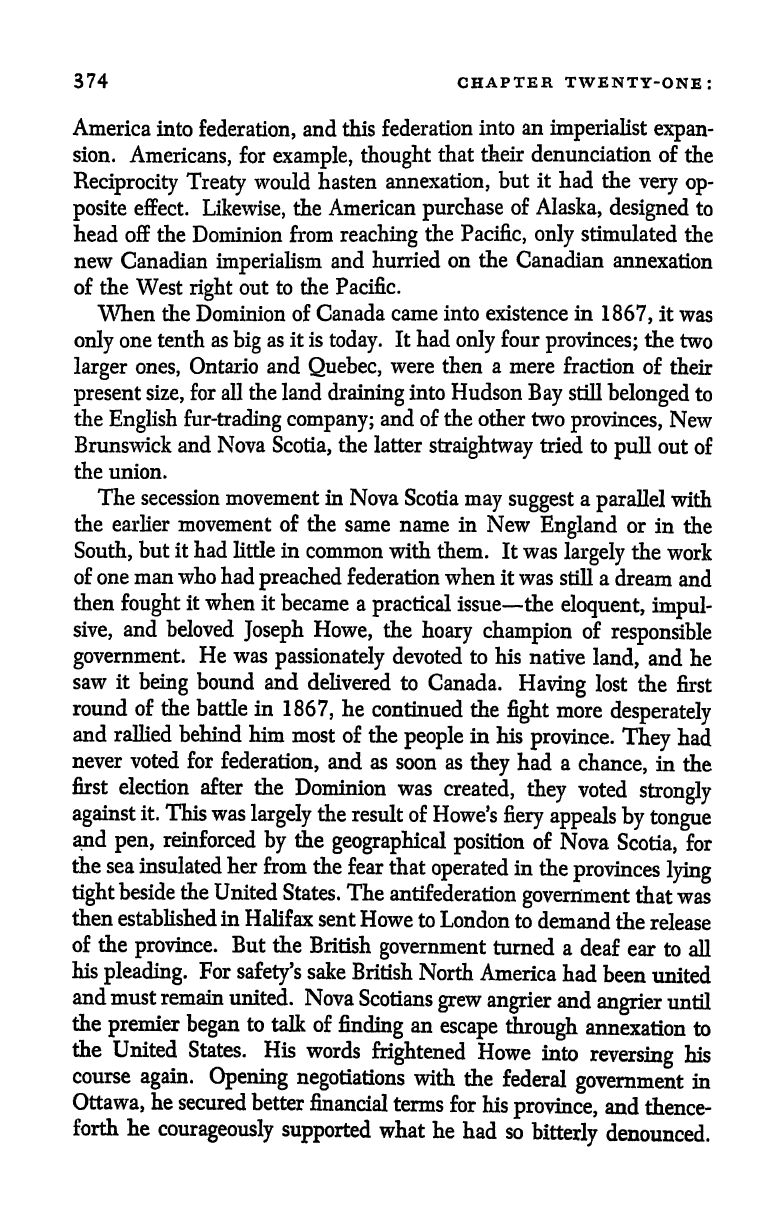
374 CHAPTER
TWENTY-ONE:
America
into
federation,
and
this
federation
into
an
imperialist
expan-
sion.
Americans,
for
example,
thought
that
their
denunciation
of
the
Reciprocity
Treaty
would
hasten
annexation,
but
it
had
the
very
op-
posite
effect.
Likewise,
the
American
purchase
of
Alaska,
designed
to
head off the Dominion from
reaching
the
Pacific,
only
stimulated
the
new
Canadian
imperialism
and
hurried
on
the
Canadian
annexation
of the
West
right
out
to the
Pacific.
When the Dominion of
Canada
came into
existence in
1867,
it
was
only
one
tenth
as
big
as it
is
today.
It had
only
four
provinces;
the
two
larger
ones,
Ontario and
Quebec,
were then
a
mere
fraction
of
their
present
size,
for
all the land
draining
into Hudson
Bay
still
belonged
to
the
English
fur-trading company;
and of the other
two
provinces,
New
Brunswick
and
Nova
Scotia,
the latter
straightway
tried to
pull
out
of
the
union.
The secession movement in
Nova Scotia
may
suggest
a
parallel
with
the
earlier movement
of the
same
name
in
New
England
or
in
the
South,
but
it had
little in
common with
them.
It
was
largely
the
work
of
one
man
who
had
preached
federation
when it was
still a
dream
and
then
fought
it
when
it
became a
practical
issue
the
eloquent,
impul-
sive,
and
beloved
Joseph
Howe,
the
hoary
champion
of
responsible
government.
He was
passionately
devoted
to
his
native
land,
and he
saw it
being
bound
and
delivered
to
Canada.
Having
lost
the
first
round
of
the battle
in
1867,
he
continued the
fight
more
desperately
and rallied
behind
him
most
of the
people
in
his
province.
They
had
never voted for
federation,
and as
soon as
they
had a
chance,
in
the
first
election
after
the
Dominion
was
created,
they
voted
strongly
against
it.
This was
largely
the
result
of
Howe's
fiery appeals
by
tongue
and
pen,
reinforced
by
tike
geographical
position
of
Nova
Scotia,
for
the sea
insulated her
from
the
fear
that
operated
in
the
provinces
lying
tight
beside the
United
States.
The
antifederation
government
that
was
then
established
in
Halifax
sent
Howe
to
London
to
demand the
release
of
the
province.
But
the
British
government
turned
a
deaf
ear
to all
his
pleading.
For
safety's
sake
British
North
America
had
been
united
and must remain
united.
Nova
Scotians
grew
angrier
and
angrier
until
the
premier
began
to talk
of
finding
an
escape
through
annexation
to
the
United States.
His
words
frightened
Howe
into
reversing
his
course
again.
Opening
negotiations
with
the
federal
government
in
Ottawa,
he
secured better
financial
terms
for
his
province,
and
thence-
forth
he
courageously
supported
what
he
had
so
bitterly
denounced.
